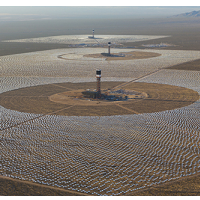Solar Farm in the Mojave Seen Igniting One Bird Every Two Minutes
 Ivanpah Solar Electric Generating System (photo: BrightSource Energy)
Ivanpah Solar Electric Generating System (photo: BrightSource Energy)
As fans of television crime shows know, it is often not a good thing for living creatures when a forensic lab is called in to assess a given situation.
In the case of the Ivanpah Solar Electric Generating System in the Mojave Desert, the creatures under scrutiny by the U.S. Fish and Wildlife Service’s (FWS) Forensics Laboratory were birds. Lots of birds. Investigators visiting one of the world’s largest solar facilities observed one bird being cooked every two minutes as they flew over the plant’s phalanx of solar mirrors.
The Associated Press said the investigators urged the state not to approve a larger version of the plant that owner BrightSource Energy wants to build.
Ivanpah has 300,000 heliostat mirrors focusing the sun’s rays on 459-foot-high tanks of water, producing steam to run a conventional turbine that produces electricity. It began producing electricity last year and came online in December. The $2.2-billion project is designed to provide power for 140,000 homes.
Observers call the birds that ignite in midair “streamers,” for the trail of smoke that follows behind them. The Center for Biological Diversity estimates that 28,000 birds are cooked annually at Ivanpah but BrightSource puts the number at 1,000. Extrapolating from Fish and Wildlife’s observation of one smoldering bird every two minutes, and allowing for 12 hours of sunlight a day, that would work out to 131,400 “streamers” a year. Add another 360 birds in a leap year.
Even if the much higher number were accurate, and no one, including the most ardent environmentalist, is saying it is, it would be dwarfed by what BrightSource says is much needed context. On its “Setting the Record Straight” webpage, the company maintains that cats kill 1.4 billion to 3.7 billion birds a year. Up to 980 million birds crash into buildings, 174 million fatally encounter power lines, up to 340 million die in vehicle/road incidents, around 6.8 million fly into communication towers, a million perish in oil and gas fluid waste pits and up to 330,000 get whacked by wind turbines.
So, really, what’s a few thousand more in a good cause? BrightSource contests assertions that “streamers” necessarily die from their encounter with Ivanpah, pointing out the investigators found that some “birds appear to be able to survive flux burns in the short term as evidenced by the collection of several live birds with singed feathers.”
Ivanpah was one of three facilities looked at by the investigators, but the only one that produced solar flux, an “intense radiant energy focused by the mirror array on the power-generating tower.” Insects as well as birds were susceptible to scorching. But birds are also attracted to the mirrors themselves, which may look like a large body of water.
Cause of death at all three plants also included impact trauma and predation. The plants themselves did not seem to attract birds, but, the report said, “Ivanpah may act as a ‘mega-trap,’ attracting insects which in turn attract insect-eating birds, which are incapacitated by solar flux injury, thus attracting predators and creating an entire food chain vulnerable to injury and death.”
The FWS report acknowledged that it did not have accurate numbers on bird deaths at Ivanpah and recommending posting cameras and being more aggressive about hunting down carcasses. But in the end investigators had a grim assessment: “The number of dead birds are likely underrepresented, perhaps vastly so.”
–Ken Broder
To Learn More:
Why Birds Are Igniting In Midair Over Calif (by Elizabeth Armstrong Moore, USA Today)
Emerging Solar Plants Scorch Birds in Mid-Air (by Ellen Knickmeyer and John Locher, Associated Press)
Setting the Record Straight: Solar Flux and Impact to Avian Species (BrightSource)
Avian Mortality at Solar Energy Facilities in Southern California: A Preliminary Analysis (by Rebecca Kagan, Tabitha Viner, Pepper Trail and Edgard Espinoza, U.S. Fish and Wildlife Forensics Laboratory) (pdf)
- Top Stories
- Controversies
- Where is the Money Going?
- California and the Nation
- Appointments and Resignations
- Unusual News
- Latest News
- California Forbids U.S. Immigration Agents from Pretending to be Police
- California Lawmakers Urged to Strip “Self-Dealing” Tax Board of Its Duties
- Big Oil’s Grip on California
- Santa Cruz Police See Homeland Security Betrayal in Use of Gang Roundup as Cover for Immigration Raid
- Oil Companies Face Deadline to Stop Polluting California Groundwater





